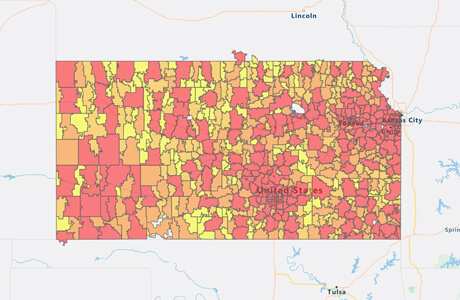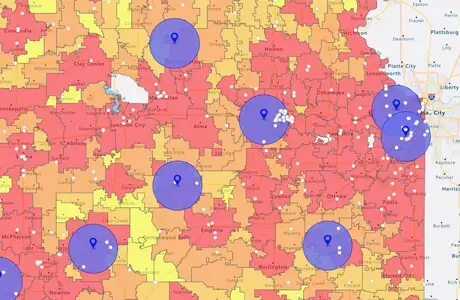What is ZIP Code Mapping?
ZIP code mapping is a method of analyzing data in relation to ZIP codes. It is usually used in comparison analysis and territory definition. As the most granular boundary dataset, it allows a more exact analysis of business data.
- Comparison analysis: This is done by linking data to ZIP code boundaries and then running a regional heat map analysis. For example, you can visualize the concentration of males aged 35-50 per ZIP code, or the volume of sales per ZIP code.
- Territory definition: Many organizations build their sales and service territories on ZIP codes as they are better able to create very clear territories.
Help With Your ZIP Code Mapping Needs
You're the expert on your data and business, but to get your ZIP code mapping project completed you'll need some support. That's why our eSpatial team includes geographic information system (GIS) qualified mapping experts who work with you. They provide expertise in both mapping software and data integration for on-boarding and through your time using eSpatial.
They can even help you find your way around our product. In fact, you should be able to speak to one of them right now through our chat function. Try it by clicking the orange icon in the bottom right corner of your screen, or schedule a call (below) for some dedicated time.

With eSpatial You Can Map ZIP Codes in the Following Ways
Color-coded ZIP Code Maps
Color-coded ZIP code maps use a range of colors to illustrate various ranges of data. Each color represents a simple value. For example each individual ZIP code can be assigned a unique color based on a value. You can also save a palette of color styles as templates. This is great when you want to create similar maps on a regular basis. You can then easily reuse these styles as you update and reload new versions of your data. Learn how to create your own color-coded ZIP code maps with our quick how-to guide.
What is a color-coded map?
A color-coded ZIP code map is a map that has different colorized ZIP code areas where each color represents a simple value. For example, each ZIP code could be differentiated and highlighted by an individual color. This makes it easy to see the different independent ZIP codes (their "value") and their geographic boundaries.
Grouping and coding ZIP codes
Alternatively, you could group a number of ZIP codes by color, to represent the same or similar values. An example of this would be a service coverage map where ZIP code regions that are covered by a service team in green versus not covered in red.
Attach spreadsheet data to colored regions
eSpatial allows you to upload Excel data and automatically attach it ("link to boundaries") to each colorized ZIP code. It allows values to be color coded on the map (e.g., covered or not covered) but can also attach additional spreadsheet data to a geographic boundary. In the service coverage map, if a ZIP is selected, an information box could open, revealing additional data such as the number of customers, number of service engineers.
Color code vs. heat map
Color-coded maps are great for simple, clear communication of distinct values that can be expressed in text form. For example, covered and not covered. However, a heat map is the best solution where there is a range of integer values to be expressed. Representing US population density on a map, for example, you could use different shades of red — dark red would indicate high density, while light red/pink would indicate low density. A range of shades that occupy the space between these extreme values would also be expressed on the map.
Layer other data onto a color-coded ZIP code map
eSpatial makes it easy to create a color-coded ZIP code map and also gives you the flexibility to save that map and use it repeatedly for different analyses. In the case of the service coverage map, for example, you could plot the number of competitors in each region.
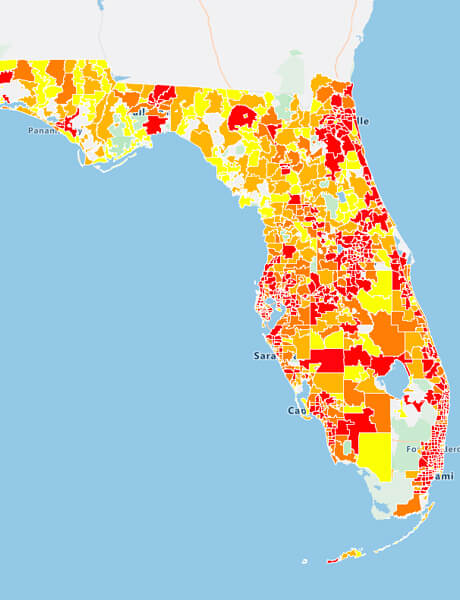
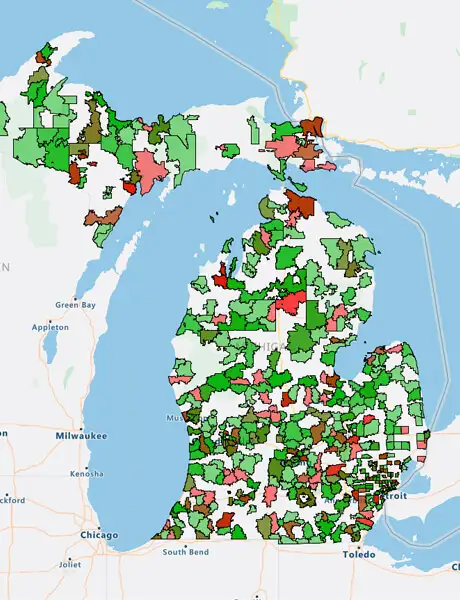
ZIP Code Territories
ZIP code territory maps allow territory managers to design territories at a more granular level than county or state territories.
Sales territories are the backbone of many sales teams. Ensuring they are aligned and balanced for an even workload across all sales personnel is key to a motivated team. The eSpatial Territory mapping software can help you start from fresh or upload your existing territories and reassign, realign and balance those too.
eSpatial allows you to balance your ZIP code territories regarding certain data, such as demographics or values. This will help identify whether the distribution of territories is balanced and fair. To get started, sign up for a free trial or log in to your eSpatial account and open the Territory Map Maker by clicking the button on the top right of your screen.
Create ZIP Code Territories From Scratch

1. Create Manually
After logging into eSpatial and opening the Territory Builder, the next screen you see will give you two options. To Create Manually or Create from File. Select Create Manually.

2. Select Your ZIP Code Territory File
You will automatically be brought to find your territories file from your laptop or desktop computer. Make sure you have the territory data on the first sheet of your file and that it is saved in CSV or XLS format.

3. Configure Your ZIP Code Territories
Here you need to select the region dataset that your territories are built on (ZIP, counties, states) and tell eSpatial which column of data matches with that dataset. You also need to select the column which will contain territory identifier data such as territory name or sales manager name.

4. Edit Your ZIP Code Territories
Once your territories have been loaded you can now edit, align and balance them as required.
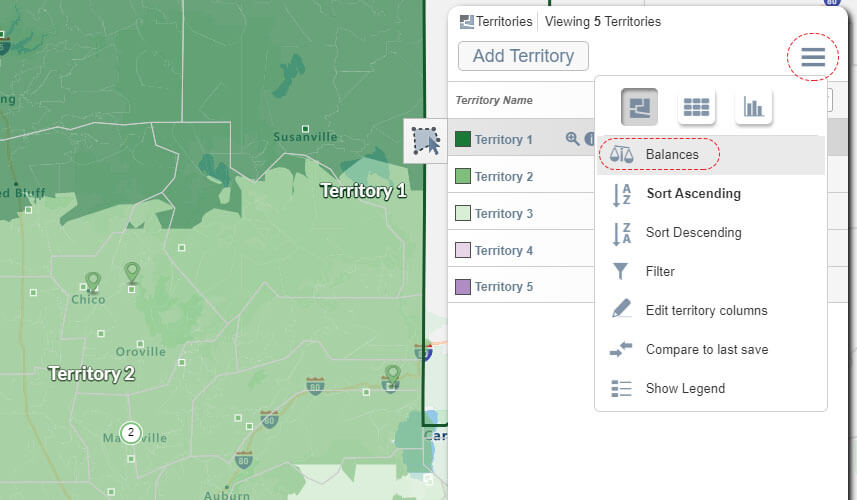
5. Balance Your Territories
- To add balance criteria, click on Add Balance.
- Select the dataset you want to pull your criteria from. You can pull the most up to date information from your CRM to ensure that you are balancing your territories on the most up-to-date information.
- Select the balance criteria you want to add to your territory builder. You can balance this on your current sales pipeline, your current account values, recent sales performance.
- Click complete and you will see your territories now have balances next to them based on the criteria you set.
ZIP Code Heat Maps
A ZIP code heat map is a regional heat map. It uses graded differences in shading or color in order to indicate the aggregate or average values of some property or quantity in particular areas. For instance, the aggregate value or volume of sales for each ZIP code or sales territory is color coded into a number of ranges, with each color representing a value range. Learn how to create your own regional heat map in our quick and easy how-to guide.
ZIP code heat maps are used to:
- Get an overview of your market performance.
- Quickly identify high and low performing areas.
- Uncover trends in sales of particular products in particular locations.
- Quickly spot areas for further investigation based on the density of sales.
Outside analysis
You can not only identify and analyze the points that lie within your ZIP code boundaries, but you can also identify the data points that lie outside your boundaries. This helps you spot gaps in your coverage.
